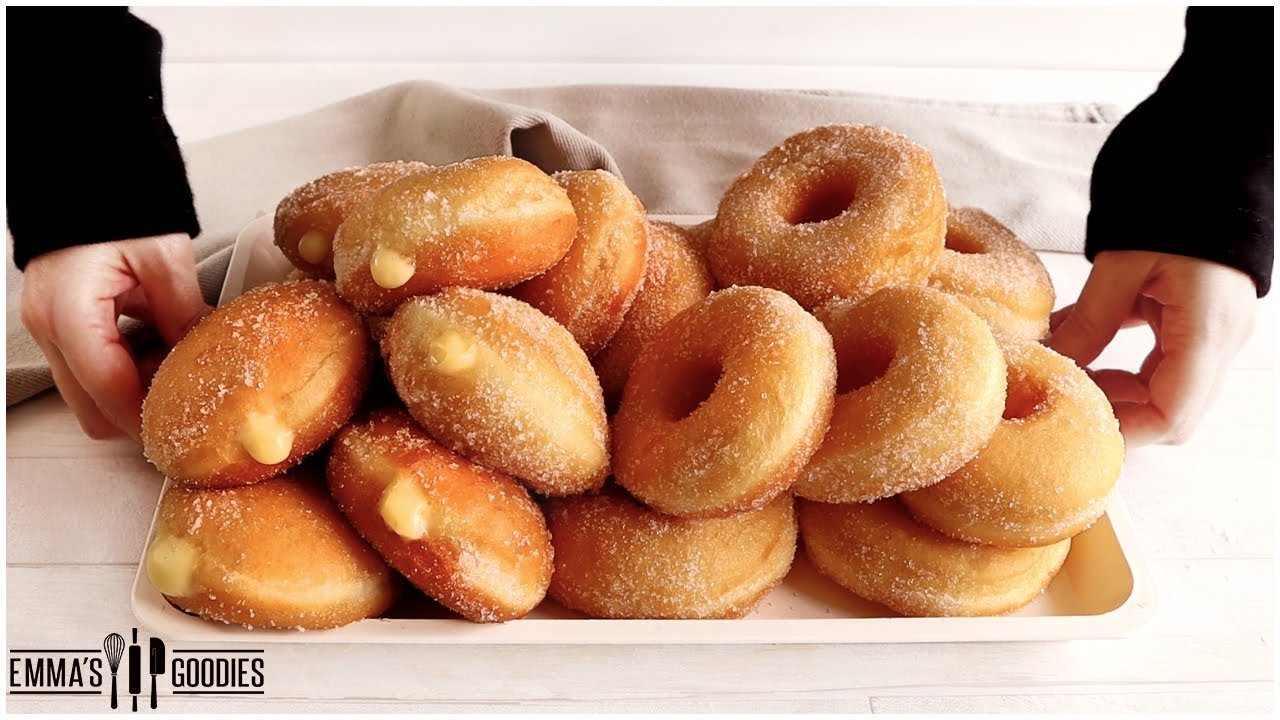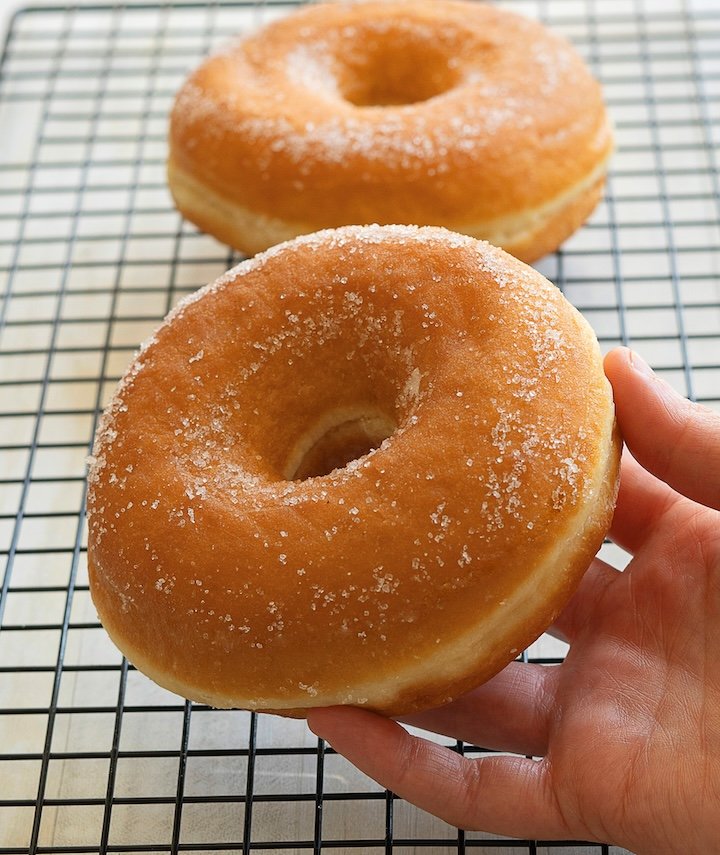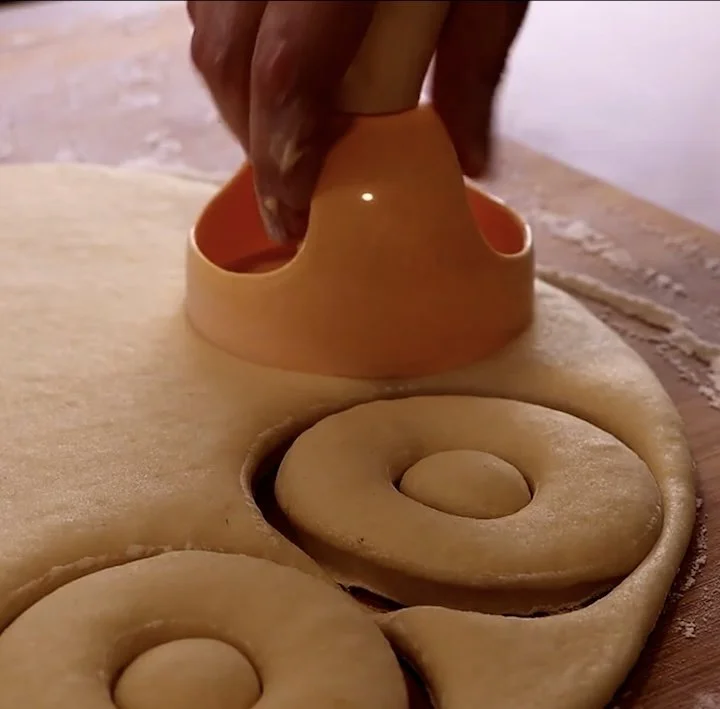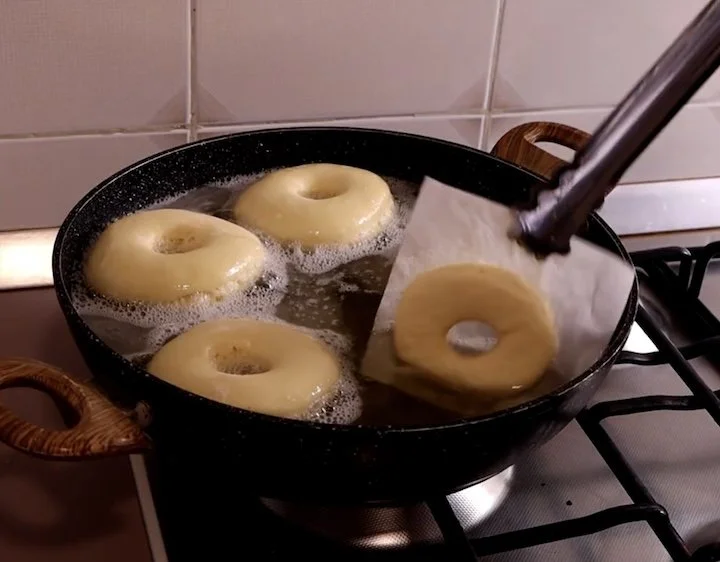Emma Fontanella’s selection of melt-in-your-mouth Italian donuts with bomboloni (on the left) and graffe (on the right)
About my Homemade Soft & Fluffy Italian Donuts Recipe
In this recipe, I’m going to make two iconic types of Italian donuts – irresistible filled donuts, called bomboloni, classic ring donuts, called graffe. These donuts can be eaten any time of the day as snacks, or as dessert. You won’t believe how fluffy and melt-in-the-mouth they are! The secret to their amazing interior texture is the used of potato in the dough. They’re coated with crunchy granulated sugar.
Italians love donuts every bit as much as Americans do! Bomboloni are eaten hot and fresh, any time, any place, including at the beach! If you’re ever at the beach in Italy, don’t be surprised to hear calls over a PA system announcing that a batch of hot, fresh donuts are ready. It’s a little like the way Krispy Kreme switches on their neon “Hot Light” signs every day when fresh donuts are ready!
If you’ve never made fried, yeast-raised donuts before, this a great place to start. The potato in the dough is a foolproof way of achieving that classic soft donut texture we all love. While these particular donuts might not be quite as famous popular Italian food exports such pizza and pasta, inside Italy, they’re absolutely iconic. I think they deserve to be every bit as well known as other Italian dishes! I mean, who doesn't love a really good donut?!
This recipe can be found in my new cookbook, Simple Pleasures. In the book you’ll find even more delicious donut recipes such as classic glazed donuts, instant donuts, donut holes and more!
What are bomboloni?
Bomboloni are Italian filled donuts. In Rome, and in some other parts of Italy, they’re also known as “bombe”. They’re similar to American jelly donuts. Their soft fluffy inside texture is complemented by their crunchy sugary exterior. You can’t help but lick your lips when you eat bomboloni!
The use of eggs and potato in the dough for bomboloni is controversial to some people. However, the truth is their use is traditional, going back hundreds of years. More important than the fact that this is historically authentic, though, is that it makes for truly delicious bomboloni!
Traditionally they’re filled with custard, like in the picture below; but they’re often filled with Nutella or jams.
A traditional Italian bombolone, filled with custard. The potato in the dough gives these donuts their extra soft and fluffy texture.
What are graffe?
Graffe are Italian ring donuts made with potato and eggs in the dough to add softness. They’re scented with citrus zest (lemon, orange or a mixture of the two), and coated in sugar. In Rome they’re also called "Ciambelle". They’re often eaten at coffee bars with really good hot coffee.
Traditional freshly made graffe—Italian ring donuts, made with potato in the dough and coated with sugar
How does potato make doughnuts soft and fluffy?
The key to how potato works to make doughnuts and breads soft is starch. When potatoes are boiled in water, the starch granules in the potato rearrange their structures to absorb and hold onto water. Potatoes are one of the starchiest of all vegetables, and so when you add cooked mashed potato to the dough, what you’re doing is adding lots of starch that’s able to hold onto its water content. This extra moistness is what makes the donuts super soft and fluffy in texture.
It works in a similar way to the popular Chinese and Japanese dough conditioning techniques, tangzhong and yudane. In those methods, however, flour that’s been gelatinized with hot water is used instead of cooked potato.
What kind of flour is best for making donuts?
For yeast-raised donuts you want a a flour with high protein content (12% or higher), such as a bread flour. That’s because we want to develop a strong gluten network in the dough, which needs a high protein flour.
For cake donuts, though, a low protein all-purpose flour (less than 11% or lower), or even a cake flour, will give you the best results. For cake type donuts, a high protein flour will tend to make the donuts tough.
What kind of oil should I use for frying the donuts?
At home, the best oils for frying donuts are oils with no flavor or aroma. Vegetable oil, peanut oil, and canola oil are all good choices. After frying donuts, once the oil as cooled, make sure to filter it to remove any solids,and store it in a sealed container for future re-use. You can re-use the same oil for frying four times or more, unless you burnt something or tainted the oil with a strongly flavored ingredient.
What is a yeast-raised donut?
Yeast-raised donuts is what most people think of as regular donuts. They’re made in a similar way to bread, with yeast added to the dough. The live yeast feeds on the flour in the dough, and in the process it creates carbon dioxide which makes the dough rise. So, the rise comes from the yeast, hence the term “yeast-raised”.
Where can I get the donut cutter Emma uses?
The donut cutter Emma uses is readily available on line e.g. at Amazon.
EQUIPMEMT
Fine mesh sieve or potato ricer (recommended but not required)
Stand mixer with dough hook attachment (recommended but not required)
Donut cutter for cutting out the ring donuts
3½-inch (9cm) round cookie or biscuit cutter
1-inch (2.5cm) round cookie cutter (optional, for ring donuts)
Instant-read thermometer
Chopstick (optional, for filled donuts)
Piping bag with ¼-inch (1cm) tip (optional, for filled donuts)
INGREDIENTS
For the donuts
1 medium high-starch potato like Yukon Gold, peeled and halved, about 4½oz (125g) when peeled
1 large egg, at room temperature
¾ cup (180g) whole milk
2 tsp (7g) active dry yeast
3 cups (420g) all-purpose flour, plus more for dusting 3 tbsp (35g) granulated white sugar
1 tsp salt
Zest of 1 lemon
4 tbsp (½ stick / 60g) unsalted butter, melted
Neutral cooking oil, for frying (about 1 quart / 1 liter)
For the filling and coating
½ cup (100g) granulated white sugar
2 cups filling of choice (optional), such as pastry cream or Nutella
INSTRUCTIONS
Make the mashed potatoes
Place the halved potato in a saucepan over high heat, add cold water to cover, and bring to a boil. Once the water is boiling, reduce the heat to medium and cook for 20 to 25 minutes or until tender.
Drain and allow the steam to escape from the potato halves for 10 minutes until dry. Mash until smooth. (Use a fine mesh sieve or a potato ricer if you have one—it's important there are no lumps.)
Cool for at least 20 minutes. You should have about ½ cup of mashed potatoes.
Activate the yeast
In a small, microwave-safe bowl or glass measuring cup, microwave the milk until lukewarm, about 30 to 40 seconds. (Don't let it get hot.) Whisk the egg into the milk and add the yeast. Allow to sit for 5 minutes.
Mix the dry ingredients
In the bowl of a stand mixer fitted with the whisk attachment, whisk together the flour, sugar, and salt. Zest the lemon directly into the mixture.
Combine and knead the dough
To the dry ingredients, add the melted butter, mashed potatoes, and the milk/egg mixture. Mix on medium-low speed until the dough comes together.
Increase the speed to high and continue kneading the dough for 1 minute more. This dough doesn't need much mixing. (Alternatively, you can make the dough by hand)
Let the dough rest
Remove the dough from the bowl, and with wet hands, shape the dough into a ball. Cover with plastic wrap and allow to rest at room temperature for 1 to 1½ hours.
Shape the donuts
Turn out the dough onto a lightly dusted work surface. Using a rolling pin, roll out the dough to about ½ inch (1.25cm) thick.
Using a round cookie or biscuit cutter, cut the dough into circles. For ring donuts, use a smaller cutter to cut out the center of each circle of dough, making a ring. (Don't cut a center hole if making bomboloni.)
Cutting out the ring donuts
Place the circles on lightly floured baking sheets. A good tip is to put each donut on a square of parchment paper.
You can re-roll the scraps and cut out more donuts. If the dough pulls back, wrap the dough in plastic wrap and allow to rest for 30 minutes. Then roll the dough out and make more donuts.
Allow the donuts to rise
Cover the donuts and allow to rise for 1 to 1½ hours.
The donuts after their final rise, ready for frying
Fry the donuts
In a large Dutch oven or heavy-bottomed pot over medium heat, heat about 3 inches (7.5cm) of oil to 350°F (180°C). When this temperature is reached, reduce the heat slightly to maintain the temperature of the oil.
Working in batches, fry the donuts until golden brown, about 1 to 2 minutes on each side.
Frying the donuts
Transfer the donuts onto paper towels, and then while still hot, toss the donuts in the granulated sugar.
Set aside to cool for 10 minutes and serve warm.
Fill the bomboloni
If you’re making bomboloni, while the donuts are still warm, use a chopstick (or a similar utensil) to make a hole in the side of each donut, inserting the chopstick just over halfway into the donut.
Using a chopstick to make space for the filling
Use a piping bag to fill them with the filling(s) of your choice. You'll know when you've put enough filling into a donut because it will feel heavy in your hand.
Filling a donut with custard
Serve
Italian donuts are best eaten fresh-as soon as possible after making them. Ideally, eat them while they’re still warm; but you really need to eat them on the same day you make them.
Watch the video for more tips
Hi! I’m Emma Fontanella. Here you’ll find trusted, tested recipes to satisfy your baking addiction and carb cravings. Learn more…
Tried one of my recipes? Please let me know on Instagram (@emmafontanella) or TikTok (@emma.fontanella)! Hashtag #emmafontanella
Search for another recipe…









